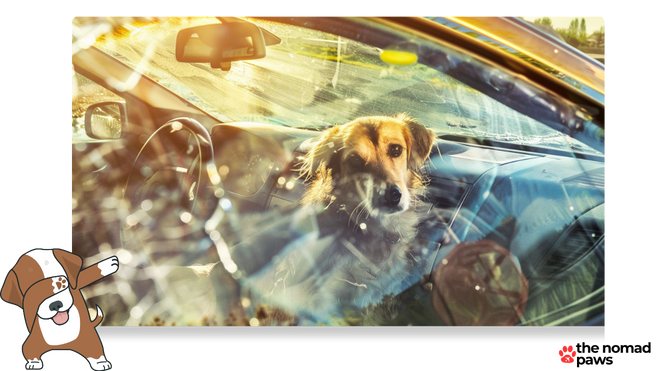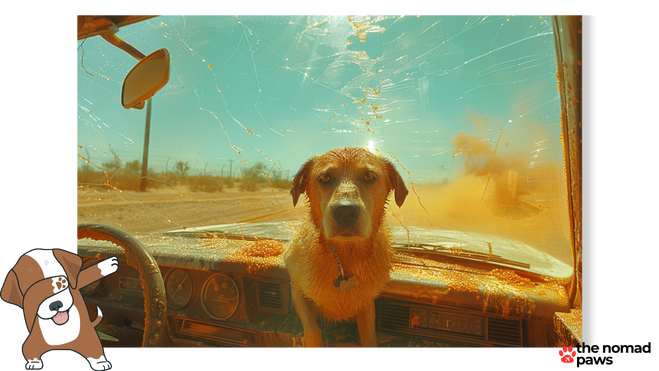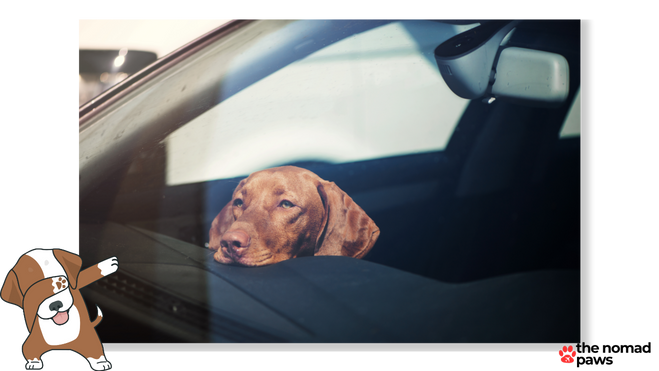You might think it’s okay to leave your furry friend in the car for just a few minutes while you run errands, but have you considered the risks?
Even on a mild day, the temperature inside a parked car can skyrocket, putting your dog in serious danger.
You need to understand how quickly the situation can turn life-threatening and what you can do to prevent tragedy.
Let’s explore the facts and misconceptions surrounding this critical topic to guarantee your dog’s safety and well-being.
How Fast Do Parked Cars Get Hot?

It may surprise you to learn that the interior temperature of a parked car can increase by an average of 40°F within one hour, regardless of the outside temperature.
This rapid heating occurs due to heat accumulation inside the vehicle, with 80% of the temperature rise happening in the first 30 minutes.
Even on a relatively important 70°F day, the interior can reach a sweltering 115°F, while on a 95°F day, it can spike to 116°F in just an hour.
These temperature spikes create significant interior dangers and car hazards for any occupants, especially pets.
Studies have shown that cracking the windows open doesn’t notably slow the heating process or decrease the maximum temperature reached inside the vehicle.
The car’s interior color also plays a role in how quickly it heats up, with dark dashboards and seats absorbing more heat than light-colored interiors. However, the exterior color has minimal effect on the internal temperature.
In addition to the air temperature, surfaces inside the car can become dangerously hot – that’s why we discussed the importance of ventilation in our page about traveling with dogs in a travel trailer.
Dashboard temperatures can reach 157°F, steering wheels 127°F, and seats 123°F in one hour on hot days.
These extreme temperatures pose severe burn risks and can quickly lead to heat exhaustion or heatstroke for dogs left in parked cars.
It’s important to understand the rapid heating process and the potential hazards it creates to ensure the safety of your furry companions during car rides and to avoid leaving them unattended in parked vehicles, even for short periods.
What Are the Risks to Dogs Inside?

When you leave your furry friend in a hot car, you’re putting them at risk of heatstroke, dehydration, brain damage, organ failure, and even death.
The enclosed space of a vehicle can quickly become an oven, with temperatures soaring to dangerous levels in mere minutes.
It’s important to understand the severity of these risks and take steps to guarantee your dog’s safety.
Heathstroke
Leaving your dog in a hot car can quickly lead to life-threatening heatstroke, which occurs when their body temperature soars above 106°F.
In just 15 minutes, this critical condition can cause organ damage and even death. Prevention methods are essential, so never leave your furry friend alone in a parked vehicle, even with the windows cracked.
Be aware of warning signs like excessive panting, drooling, vomiting, seizures, and collapse. If you suspect heatstroke, immediate emergency response is important.
Move your dog to a cool area, offer water, and contact a vet right away.
Remember, dogs struggle with temperature regulation compared to humans, so what feels warm to you could be hazardous for them.
Raising awareness about the risks of hot cars is necessary for keeping our canine companions safe.
Dehydration
Dogs trapped in hot cars face another serious threat: rapid dehydration. The scorching environment causes them to lose fluids quickly through excessive panting, putting them at risk of severe dehydration.
Signs of dehydration include dry nose and gums, sunken eyes, lethargy, and loss of skin elasticity.
If you suspect your dog is dehydrated, offer fresh water immediately and seek veterinary care for proper treatment like IV fluids if needed.
To prevent dehydration, always provide access to clean water, especially during hot weather. Never leave your dog in a parked car, even with windows cracked, as temperatures rapidly soar to dangerous levels.
When traveling with your furry companion, take frequent breaks for water and potty time.
Brain damage
Extreme heat exposure can inflict devastating, irreversible brain damage on dogs trapped in sweltering cars.
The symptoms of brain damage may not appear immediately, but can manifest as behavioral changes, seizures, and neurological issues in the following hours or days.
If you suspect your dog has suffered heat-related brain damage, seek veterinary treatment right away. While some effects might be treatable, the long-term consequences can be severe and permanent.
To avoid brain damage, never leave your dog in a parked car, even for a little while or with the windows cracked. It gets super hot in there real quick, and dogs can’t handle it.
If you can’t take your furry buddy with you, just leave them at home where they’ll be safe.
Organ failure
In addition to brain damage, heatstroke from being trapped in a sweltering car can cause a dog’s essential organs to fail.
When a dog’s body temperature rises to dangerous levels, it triggers widespread cellular breakdown that can lead to devastating consequences for their crucial organs.
The intense heat can cause severe kidney damage, impairing the organ’s ability to filter toxins and regulate fluid balance.
Liver failure is another serious risk, as the extreme temperatures can cause the liver cells to die off rapidly.
A dog’s heart is also put under immense strain during heatstroke, potentially leading to heart issues like arrhythmias or even cardiac arrest.
As the dog’s body struggles to cope with the oppressive heat, the cumulative damage from cellular breakdown can ultimately result in multiple organ failure.
This life-threatening condition requires immediate veterinary intervention, but even with prompt treatment, the prognosis for a dog suffering from heatstroke-induced organ failure is often grim.
Death
If left untreated, the devastating effects of heatstroke can quickly lead to a tragic outcome for your beloved companion.
Leaving your dog in a hot car, even for a short time, can result in serious consequences and an unnecessary risk to their life.
The temperature inside a vehicle can rise rapidly, reaching dangerous levels that can cause irreversible damage to your pet’s health.
In as little as 15 minutes, your dog could suffer from organ failure and ultimately face death, a preventable tragedy that no pet owner wants to experience.
It’s important to understand that this heartbreaking loss is an avoidable mistake. By choosing not to leave your dog in a hot car, you can protect them from the life-threatening effects of heatstroke. Remember, your furry friend relies on you to keep them safe and healthy.
Is Leaving a Dog in a Car Illegal?

Leaving your dog unattended in a vehicle can be illegal, depending on the circumstances and the laws in your state.
In at least 19 states and Washington D.C., it’s explicitly illegal to leave your pet in a car under extreme temperatures or life-threatening conditions, and you could face animal cruelty charges.
The legal consequences vary by state, ranging from fines to jail time. Even if your state doesn’t have a specific law, leaving your dog in a dangerous situation could still constitute animal cruelty under general statutes.
Public awareness about the risks of leaving dogs in cars has increased in recent years, as has the focus on pet safety and responsible ownership.
Many states have enacted laws to protect animals and allow emergency response from law enforcement, first responders, or animal control officers.
Some states even have ‘Good Samaritan‘ laws that grant civil immunity to civilians who rescue a distressed animal from a vehicle under certain circumstances, like contacting authorities first.
The safest approach is to never leave your dog unattended in a car. Interior temperatures can rise to life-threatening levels very quickly, even on mild days. If you see a distressed animal in a vehicle, notify law enforcement immediately.
As a responsible pet owner, it’s essential to prioritize your dog’s safety and well-being.
Educate yourself about the laws in your state and take steps to make sure your furry friend is never left in a dangerous situation. Remember, a quick errand could turn into a tragic mistake.
Do Cracked Windows or Shade Make It Safe?

Many people mistakenly believe that cracking the windows or parking in the shade will keep a dog safe in a parked car, but it’s still extremely dangerous.
Studies have proven that the window effectiveness in reducing the car’s interior temperature is minimal. Even with windows cracked a couple of inches, temperatures can quickly soar to life-threatening levels.
Don’t fall for the shade misconception either. While parking in the shade might provide temporary relief, it doesn’t prevent the car from heating up to unsafe temperatures as the sun moves and shade disappears.
The temperature impact inside a parked car is staggering. On a 70°F day, which feels relatively mild, the interior can reach over 115°F within an hour. Imagine how much worse it gets on hotter days!
This rapid heat rise poses severe safety concerns for any dog left alone in a vehicle, even for a short time.
Cracking windows or seeking shade may provide a false sense of security, but it doesn’t change the fact that leaving your dog unattended in a parked car is never safe. The risk of heatstroke, organ damage, and even death is far too high.
What to Do If You See a Dog Inside?
Spotting a dog trapped inside a hot car demands swift, decisive action to guarantee their safety and well-being.
After providing emergency first aid to a dog suffering from heatstroke, you should seek immediate veterinary treatment to safeguard their well-being.
Like we have seen in our guide to keep your doog cool when you go camping, heatstroke can cause severe internal damage that may not be immediately apparent, such as organ failure, blood clotting disorders, and neurological issues.
In this case, professional veterinary will help you assess the extent of the damage, provide necessary supportive care, and monitor the dog’s recovery.
Don’t Play With Your Dog’s Life

You shouldn’t leave your dog in a hot car, even for a short time. It’s not only dangerous for your furry friend but also illegal in many places. Cracked windows and shade don’t make it safe.
If you see a dog in distress, call for help immediately. Prevention is key, so always take your dog with you or leave them at home.
Remember, your dog’s life depends on you making the right choice.






